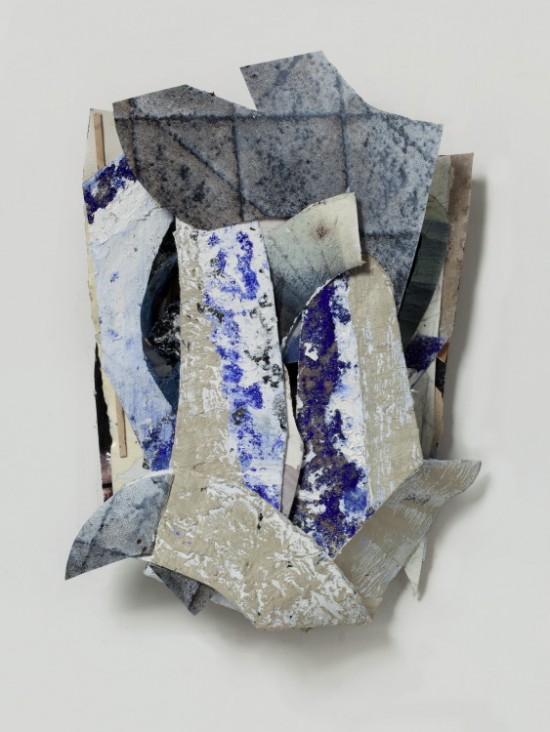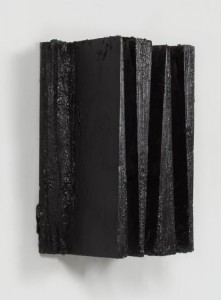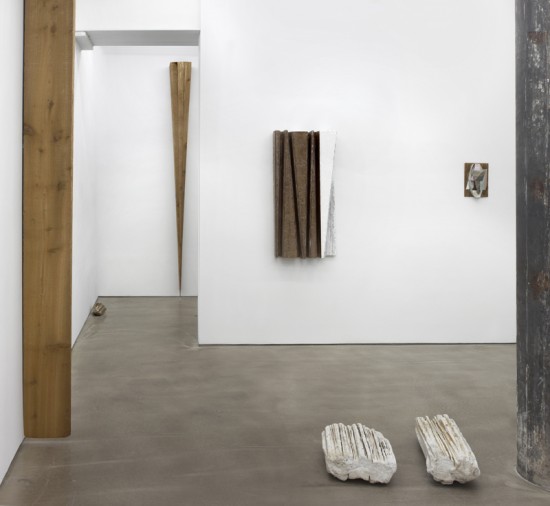
Jean Arp used seashells and blood; Jean Dubuffet, butterfly wings and glue; Bruce Conner, nylon hosiery and nails. Joseph Montgomery uses nonesuch provocative materials in his assemblages, part of the show Velveteen, now on view at Laurel Gitlen, the polished, new gallery on the Lower East Side. Instead, he uses what one would find in the garage of the average do-it-yourselfer–canvas, clay, lacquer, oil, sheet metal, and plastic—weaving, painting and affixing them on panels averaging 12.5”x 10.5” x 3” deep. Less noteworthy than the use of found, masculine materials, is the skill with which the artist successfully unifies disparate textures using high value colors. His work solicits a calm and restrained response uncharacteristic of a medium which has been disturbing audiences for a century since the advent of the first modern collage by Picasso in 1912 and “God”, the first modern assemblage by Baroness Elsa von Freytag-Loringhoven and Morton Schamberg in 1918—a work which featured plumbing fittings.
Historically, assemblage has mixed substandard materials to yield a kind of anti-art which pasted, pressed, glued, nailed, cut, stapled and painted “found”, previously intact, and everyday objects into new, expanded forms. Montgomery’s assemblages (called paintings by the gallery) have much in common with two-dimensional abstract paintings such as Robert Motherwell’s Western Air (1946) and Gertrude Greene’s Monumentality (1949), only re-imagined as three-dimensional relief sculptures. The stronger precedent can be found in Jean Pougny’s (Ivan Puni) 1915 Suprematist Sculpture which might account for their “strange familiarity”.
Velveteen’s locus of inquiry in sculpture continues with minimalist sculptures made of shims, or tapered pieces of wood. On one end of the continuum are Large Shim: 13 and Large Shim: 7, two 10-foot tall wall-mounted, natural, red cedar shims in varying widths. The strong wedge shapes, suggesting exclamation points minus the dots, share the enthusiasm of Hisayuki Mogami’s 1962 curvilinear pine sculpture Laugh, Laugh, Laugh.
The most muscular of the shim series is Image One Hundred Thirty, a protruding, black lacquer wall sculpture of cedar shims arranged as alternating wedges and suggesting charred wood. Additionally, three similar wall sculptures use cedar or cardboard constructs mimicking shims with faux wood finishes or covered in white paint.
On the other end, two large marbles marked with the deep indentations of a marble saw rest on the floor. The found objects pulled from a Vermont stream have much in common with the wall sculptures, although they predate them, temporarily filling in the gap where the “paintings” did not yet exist, the artist wondering if their “resemblance” to the paintings suggest that all images are “just waiting to be found”.
All images courtesy Laurel Gitlen




 RSS
RSS
